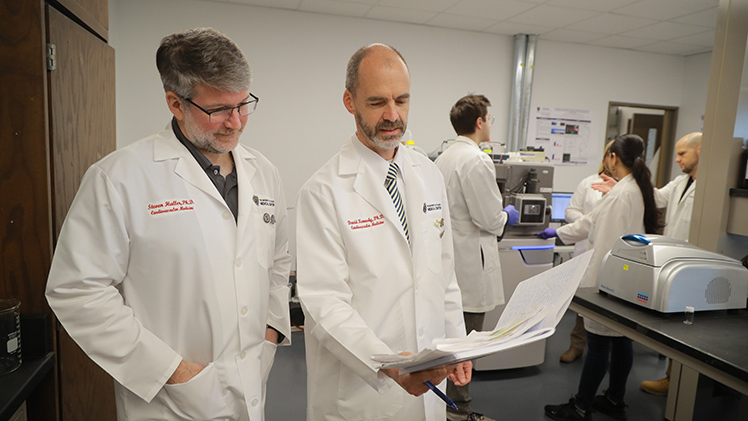Harmful algal blooms and invasive species may be top of mind when many people think about environmental risks in the Great Lakes, but they aren’t the only potential threats.
“Microplastics, forever chemicals and residual pharmaceuticals regularly get flushed into our wastewater system and ultimately wind up in our lakes,” said Dr. David Kennedy, an associate professor of medicine at The University of Toledo. “We know these contaminants are here. What we don’t fully know is the threat they may pose to human health.”

Dr. Steven Haller, left, and Dr. David Kennedy, both associate professors of medicine at UToledo, are investigating the health effects of additional Great Lakes contaminants including microplastics and forever chemicals.
An ongoing UToledo study funded by the Ohio Sea Grant hopes to provide some of those answers.
Working with liver and kidney cells collected from biopsies of patients with and without Type 2 diabetes, Kennedy and Dr. Steven Haller, also an associate professor of medicine, are studying what happens to human cells when they are exposed to those three chemicals — all of which prior research has found are abundant in the Great Lakes.
Perfluoroocatnoic acid, or PFOA, is a “forever chemical” widely used in the manufacturing of consumer goods. Microplastics come from a variety of sources, including beads used in health and beauty products. The pharmaceutical compound they tested, 17a-ethynylestradiol, is a synthetic hormone commonly used in oral contraceptives.
Initial findings from their toxicology studies indicated exposure to perfluorooctanoic acid suppressed the immune response, while exposure to microplastics and residual pharmaceuticals increased inflammation and markers of kidney injury, respectively.
In addition to sharing their findings with local health departments, some of the early findings were presented at national and international scientific meetings, including the Biomedical Engineering Society and the European Commission Directorate General Joint Research Centre.
Kennedy and Haller have spent the better part of a decade studying the health effects of blue-green algae and the cyanotoxins those annual blooms can produce, particularly in individuals with pre-existing conditions.
As in their continuing work with cyanotoxins, the new project attempts to get as close as possible to answering questions about real-world exposures. Each of the three contaminants were tested at levels scientifically documented to be present in the Great Lakes, and by using human cells from the start they sidestep the need for animal models.
Notably, the study found the respective effects of all three toxins were heightened in cells from patients with diabetes — suggesting individuals with metabolic disorders may be at increased risk.
“Diabetics often have issues with how fat gets processed and stored in the liver and the kidney,” Haller said. “Those two organs — both of which play a role in breaking down and removing toxins from the body — are already being stressed. When they’re storing fat, they don’t have as much room to perform their regular functions. There’s a clear amplification of the effects of these chemicals in individuals with diabetes.”
One of the researchers’ main goals is providing direction for public health authorities.
“These are emergent threats and there aren’t yet agreed upon guidelines for what level of exposure is safe versus what may be harmful,” Haller said. “As we continue to investigate this, we anticipate being able to help develop those guidelines.”
By determining which contaminants have the most potential for causing negative health effects, the study also could help to prioritize the development of non-invasive diagnostic tests.
“Right now, there are no easy tests for determining exposure to any of these chemicals,” Kennedy said. “If we know which ones have the highest potential for causing harmful effects, we can help public health officials better allocate their limited resources.”
In addition to learning more about how each of the three pollutants can singularly impact human health, the research team also is looking at the effects they may have in concert with one another and with other toxins such as microcystin.
Microplastics, for example, are great at absorbing toxins. As the microscopic particles make their way through the blood stream and cross into cell membranes they can easily deposit those absorbed toxins directly into cells.
“There’s no question that it’s not just harmful algal blooms. The lake is a big and complex thing,” Haller said. “We absolutely think the next step to our research is to study how all these threats interact and how those combinational affects are impacting human health.”
The research team also included Shereen Yassine, a bioengineering undergraduate student; Ben French, a Ph.D. student in the College of Medicine and Life Sciences’ Biomedical Science Program; research assistant Andrew Kleinhenz; and Joshua Breidenbach, who recently graduated from UToledo with a Ph.D. in medical microbiology and immunology.